Citibank 2010 Annual Report Download - page 257
Download and view the complete annual report
Please find page 257 of the 2010 Citibank annual report below. You can navigate through the pages in the report by either clicking on the pages listed below, or by using the keyword search tool below to find specific information within the annual report.-
 1
1 -
 2
2 -
 3
3 -
 4
4 -
 5
5 -
 6
6 -
 7
7 -
 8
8 -
 9
9 -
 10
10 -
 11
11 -
 12
12 -
 13
13 -
 14
14 -
 15
15 -
 16
16 -
 17
17 -
 18
18 -
 19
19 -
 20
20 -
 21
21 -
 22
22 -
 23
23 -
 24
24 -
 25
25 -
 26
26 -
 27
27 -
 28
28 -
 29
29 -
 30
30 -
 31
31 -
 32
32 -
 33
33 -
 34
34 -
 35
35 -
 36
36 -
 37
37 -
 38
38 -
 39
39 -
 40
40 -
 41
41 -
 42
42 -
 43
43 -
 44
44 -
 45
45 -
 46
46 -
 47
47 -
 48
48 -
 49
49 -
 50
50 -
 51
51 -
 52
52 -
 53
53 -
 54
54 -
 55
55 -
 56
56 -
 57
57 -
 58
58 -
 59
59 -
 60
60 -
 61
61 -
 62
62 -
 63
63 -
 64
64 -
 65
65 -
 66
66 -
 67
67 -
 68
68 -
 69
69 -
 70
70 -
 71
71 -
 72
72 -
 73
73 -
 74
74 -
 75
75 -
 76
76 -
 77
77 -
 78
78 -
 79
79 -
 80
80 -
 81
81 -
 82
82 -
 83
83 -
 84
84 -
 85
85 -
 86
86 -
 87
87 -
 88
88 -
 89
89 -
 90
90 -
 91
91 -
 92
92 -
 93
93 -
 94
94 -
 95
95 -
 96
96 -
 97
97 -
 98
98 -
 99
99 -
 100
100 -
 101
101 -
 102
102 -
 103
103 -
 104
104 -
 105
105 -
 106
106 -
 107
107 -
 108
108 -
 109
109 -
 110
110 -
 111
111 -
 112
112 -
 113
113 -
 114
114 -
 115
115 -
 116
116 -
 117
117 -
 118
118 -
 119
119 -
 120
120 -
 121
121 -
 122
122 -
 123
123 -
 124
124 -
 125
125 -
 126
126 -
 127
127 -
 128
128 -
 129
129 -
 130
130 -
 131
131 -
 132
132 -
 133
133 -
 134
134 -
 135
135 -
 136
136 -
 137
137 -
 138
138 -
 139
139 -
 140
140 -
 141
141 -
 142
142 -
 143
143 -
 144
144 -
 145
145 -
 146
146 -
 147
147 -
 148
148 -
 149
149 -
 150
150 -
 151
151 -
 152
152 -
 153
153 -
 154
154 -
 155
155 -
 156
156 -
 157
157 -
 158
158 -
 159
159 -
 160
160 -
 161
161 -
 162
162 -
 163
163 -
 164
164 -
 165
165 -
 166
166 -
 167
167 -
 168
168 -
 169
169 -
 170
170 -
 171
171 -
 172
172 -
 173
173 -
 174
174 -
 175
175 -
 176
176 -
 177
177 -
 178
178 -
 179
179 -
 180
180 -
 181
181 -
 182
182 -
 183
183 -
 184
184 -
 185
185 -
 186
186 -
 187
187 -
 188
188 -
 189
189 -
 190
190 -
 191
191 -
 192
192 -
 193
193 -
 194
194 -
 195
195 -
 196
196 -
 197
197 -
 198
198 -
 199
199 -
 200
200 -
 201
201 -
 202
202 -
 203
203 -
 204
204 -
 205
205 -
 206
206 -
 207
207 -
 208
208 -
 209
209 -
 210
210 -
 211
211 -
 212
212 -
 213
213 -
 214
214 -
 215
215 -
 216
216 -
 217
217 -
 218
218 -
 219
219 -
 220
220 -
 221
221 -
 222
222 -
 223
223 -
 224
224 -
 225
225 -
 226
226 -
 227
227 -
 228
228 -
 229
229 -
 230
230 -
 231
231 -
 232
232 -
 233
233 -
 234
234 -
 235
235 -
 236
236 -
 237
237 -
 238
238 -
 239
239 -
 240
240 -
 241
241 -
 242
242 -
 243
243 -
 244
244 -
 245
245 -
 246
246 -
 247
247 -
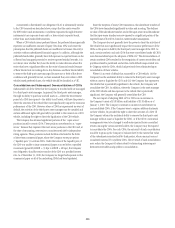 248
248 -
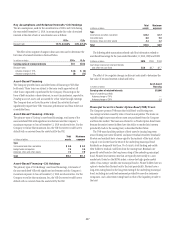 249
249 -
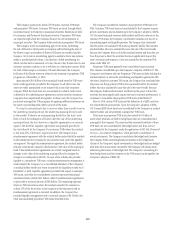 250
250 -
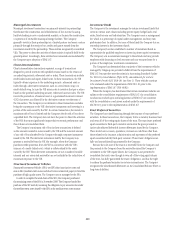 251
251 -
 252
252 -
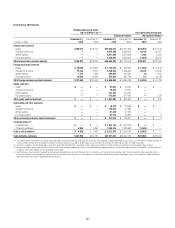 253
253 -
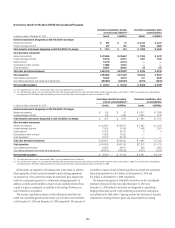 254
254 -
 255
255 -
 256
256 -
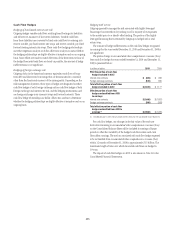 257
257 -
 258
258 -
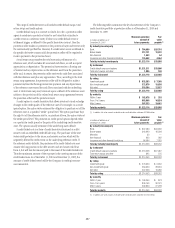 259
259 -
 260
260 -
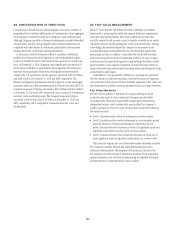 261
261 -
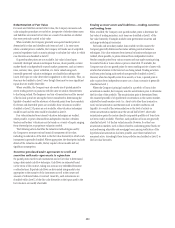 262
262 -
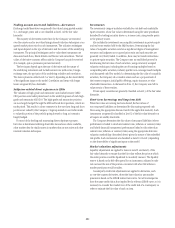 263
263 -
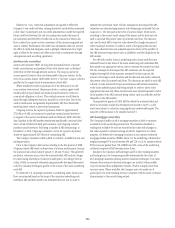 264
264 -
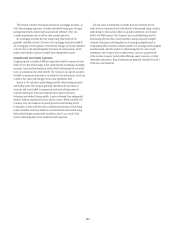 265
265 -
 266
266 -
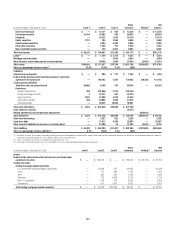 267
267 -
 268
268 -
 269
269 -
 270
270 -
 271
271 -
 272
272 -
 273
273 -
 274
274 -
 275
275 -
 276
276 -
 277
277 -
 278
278 -
 279
279 -
 280
280 -
 281
281 -
 282
282 -
 283
283 -
 284
284 -
 285
285 -
 286
286 -
 287
287 -
 288
288 -
 289
289 -
 290
290 -
 291
291 -
 292
292 -
 293
293 -
 294
294 -
 295
295 -
 296
296 -
 297
297 -
 298
298 -
 299
299 -
 300
300 -
 301
301 -
 302
302 -
 303
303 -
 304
304 -
 305
305 -
 306
306 -
 307
307 -
 308
308 -
 309
309 -
 310
310 -
 311
311 -
 312
312
 |
 |

255
Cash Flow Hedges
Hedging of benchmark interest rate risk
Citigroup hedges variable cash flows resulting from floating-rate liabilities
and rollover (re-issuance) of short-term liabilities. Variable cash flows
from those liabilities are converted to fixed-rate cash flows by entering into
receive-variable, pay-fixed interest rate swaps and receive-variable, pay-fixed
forward-starting interest rate swaps. These cash-flow hedging relationships
use either regression analysis or dollar-offset ratio analysis to assess whether
the hedging relationships are highly effective at inception and on an ongoing
basis. Since efforts are made to match the terms of the derivatives to those of
the hedged forecasted cash flows as closely as possible, the amount of hedge
ineffectiveness is not significant.
Hedging of foreign exchange risk
Citigroup locks in the functional currency equivalent cash flows of long-
term debt and short-term borrowings that are denominated in a currency
other than the functional currency of the issuing entity. Depending on the
risk management objectives, these types of hedges are designated as either
cash flow hedges of only foreign exchange risk or cash flow hedges of both
foreign exchange and interest rate risk, and the hedging instruments used
are foreign exchange cross-currency swaps and forward contracts. These
cash flow hedge relationships use dollar-offset ratio analysis to determine
whether the hedging relationships are highly effective at inception and on an
ongoing basis.
Hedging total return
Citigroup generally manages the risk associated with highly leveraged
financing it has entered into by seeking to sell a majority of its exposures
to the market prior to or shortly after funding. The portion of the highly
leveraged financing that is retained by Citigroup is hedged with a total
return swap.
The amount of hedge ineffectiveness on the cash flow hedges recognized
in earnings for the years ended December 31, 2010 and December 31, 2009 is
not significant.
The pretax change in Accumulated other comprehensive income (loss)
from cash flow hedges for years ended December 31, 2010 and December 31,
2009 is presented below:
In millions of dollars 2010 2009
Effective portion of cash flow
hedges included in AOCI
Interest rate contracts $ (469) $ 488
Foreign exchange contracts (570) 689
Total effective portion of cash flow
hedges included in AOCI $(1,039) $ 1,177
Effective portion of cash flow
hedges reclassified from AOCI
to earnings
Interest rate contracts $(1,400) $ (1,687)
Foreign exchange contracts (500) (308)
Total effective portion of cash flow
hedges reclassified from AOCI to
earnings (1) $(1,900) $ (1,995)
(1) Included primarily in Other revenue and Net interest revenue on the Consolidated Income Statement.
For cash flow hedges, any changes in the fair value of the end-user
derivative remaining in Accumulated other comprehensive income (loss)
on the Consolidated Balance Sheet will be included in earnings of future
periods to offset the variability of the hedged cash flows when such cash
flows affect earnings. The net loss associated with cash flow hedges expected
to be reclassified from Accumulated other comprehensive income (loss)
within 12 months of December 31, 2010 is approximately $1.5 billion. The
maximum length of time over which forecasted cash flows are hedged is
10 years.
The impact of cash flow hedges on AOCI is also shown in Note 21 to the
Consolidated Financial Statements.
